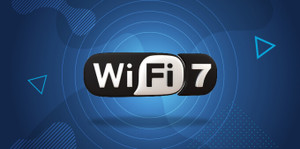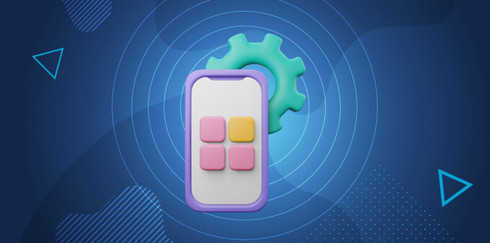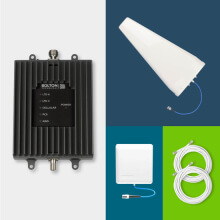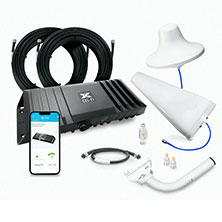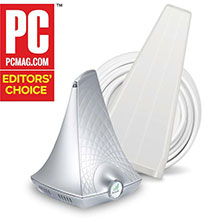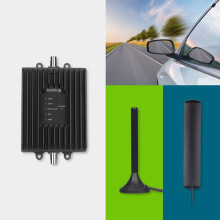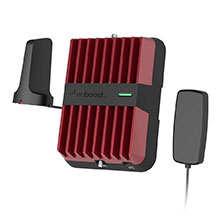Best Apps To Test Cell Phone Signal Strength
Looking for a convenient way to test your cell phone signal strength? There are many apps available that can tell you precisely how good or bad your reception is. Some can also help you find your nearest cell tower.
This information is extremely important if you want to address your lousy cell reception with a cell phone signal booster. In this blog, we'll be going over our favorite apps to measure cell signal strength.
Take advantage of our system design and installation services. Learn more or call us for a free consultation: 1-800-969-8189.
But First: Best Way to Accurately Measure Signal Strength
Cell phone signal bar readings for both 5G and 4G aren't reliable. They vary, depending on the model of your phone and your cell phone carrier. One bar on AT&T could mean full bars on T-Mobile, which could be two bars on Verizon.
Generally, having more bars does tend to indicate stronger signal strength, although there is no real standard. For the most precise reading, we recommend measuring mobile signal strength in (decibel milliwatts).
dBm readings are a consistent unit of measurement. They aren't one-sided and can't be tampered with by your phone manufacturer or carrier. Cell signal strength tends to range from -50 dBm to -120 dBm. The closer your signal is to 0 dBm, the stronger it is.
Typically:
- -50 dBm and Higher: Outstanding Signal
- -50 dBm to -65 dBm: Very Good Signal
- -65 dBm to -80 dBm: Good Signal
- -80 dBm to -100 dBm: Weak Signal
- -100 dBm to -120 dBm: Very Weak Signal
How Do You Check Cell Signal Strength?
There are two main ways to check cell signal strength: field test method and apps. We'll start with the top 5 smartphone signal strength apps, and explain field test mode later.
5 Apps to Mesure 4G and 5G Signal Strength On Android and iPhone
1. weBoost App
Available on Google Play and the App Store
Being a cell phone signal booster manufacturer, weBoost designed an app to simplify installation. One of its functions is measuring cellular signal strength.
Extremely user-friendly, anybody can use it. For Android users, measuring your signal is as simple as tapping a button. On iPhones, the app walks you through field test mode to measure signal strength.
A weBoost cellular booster is not needed to use the app.
2. Network Cell Info Lite
Available on Google Play Store
Network Cell Info is our favorite cell signal strength app for Androids. It covers all cellular networks including 5G, LTE, HSPA +, HSPA, WCDMA, EDGE, GSM, CDMA, and EVDO.
As soon as you open the app, it automatically starts measuring signal strength. It also measures signal noise which affects signal quality. As you move locations, the app continuously updates. You don't have to tap a button to get your dBm reading.
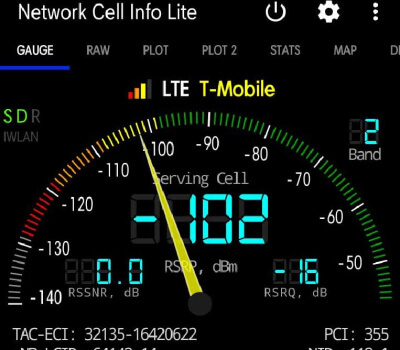
3. Signal Strength
Available on Google Play Store
Signal Strength is a super basic WiFi and cell phone signal strength app. Upon opening the app, it will start detecting your signal strength real time. Make sure the 4G or 5G cellular tab is selected.
By default, the app rates your signal from low to good and measures it in ASU. For dBm, tap the dB icon on the top left corner.
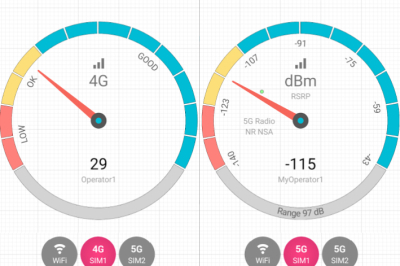
4. LTE Discovery
Available on some Google Play Store
This app analyzes LTE, 4G, and 5G signals. While it may not boast the best layout, it's pretty straightforward.
Signal strength is automatically calculated on the top left corner. Like the Network Cell Info Lite app, it automatically updates after a few seconds as you move around. Lower on the screen, it also identifies the direction of the cell tower you're connected to.
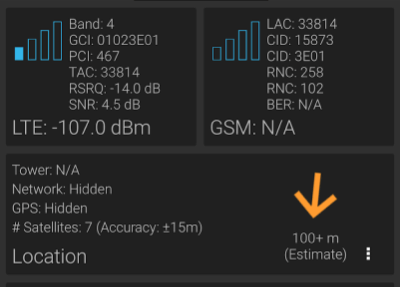
5. Open Signal
Available on Google Play and the App Store
OpenSignal doesn't provide dBm readings. Though, it's still worth mentioning, especially for iPhone users as it's more difficult to test signal strength on iPhones.
If unable to get your dBm readings through an app or field test mode, OpenSignal is a great resource. It allows you to test your WiFi and 4G/5G data speeds. Areas that yield a higher speed have a stronger signal.
It also features cell coverage heat maps to assess the quality of coverage from any carrier in your area. Data is crowdsourced, ensuring the most precise and reliable results.
Field Test Mode - Get Reliable Signal Readings Without an App
Unfortunately, there aren't many apps to measure cell signal strength on iPhones. If you have an iPhone, field test mode may be your best bet. However, signal strength readings through field test mode are not available on all iPhones, but it's worth a shot. If you have an Android, measuring signal strength through field test mode is just as easy as with an app.
The field test method will differ depending on your operating system. We have an entire article on Field Test Mode, but here is a basic overview of how to check your signal strength straight from your phone.
How to Find Precise dBm Readings on Your iPhone
The Field Test menu has had some variations on each iPhone version; nevertheless, this mini-guide should work on most iOS systems. Note that it may not work on every phone.
- Open the Control Center (or go to the Settings app). Remember to turn off your Wi-Fi
- After you've done this, open the Phone app and insert the following, exactly as you see it: *3001#12345#*
- Press call and you will see the Field Test menu.
- Find the RSRP number. That will show you your signal strength.
If this doesn’t work, your phone is one of the unfortunate ones that has no real way of measuring its dBm.
How to Find Precise dBm Reading on Your Android
Field test mode on Android varies by phone model and Android OS version. However, you can generally find it under the Settings menu.
Typical sequence:
- Tap Settings
- Tap About Phone
- Tap Status or Network
- Tap SIM Status
- Your dBm is under Signal strength
Once you have your signal measurement, walk around inside and outside the perimeter of your home to test your signal.
How To Fix Bad Cell Signal
If you're trying to test your cell signal, it's likely causing you problems. Fortunately, there are ways to improve it.
They're called cell phone signal boosters, and they take weak cell service, amplify it, and rebroadcast it in a building or vehicle. If you've never heard of them, we have an article on how cell phone signal boosters work, but rest assured - they get the job done.
Best Home Signal Booster Kits
Bolton Victory Yagi/Panel Cellular Signal Booster
Overview of the Bolton Victory Yagi/Panel:
- For Small to Medium Size Homes and Offices
- Covers Up to 4,000 Sq Ft
- Up to +72 dB Gain
- Up to 26 dBm Uplink Power
- Supports All Carriers Simultaneously
The Bolton Victory Yagi/Panel cellular booster is our top pick for rural areas. Under optimal conditions, it can blanket up to 4,000 sq ft with stronger cell reception, which is more than enough for most people. Featuring up to 26 dBm uplink and up to 72 dB gain, it has incredible reach and can significantly amplify your existing weak cellular signal.
Strategically paired with the Bolton Quicksilver Outdoor Yagi Antenna, it works wonders in remote locations. This antenna is designed to draw in signals from cell towers up to 5 miles away. Distance from the signal source will no longer be a problem.
While capable of boosting multiple carriers at the same time, you may only receive improved cell reception from one or two carriers. This is because the antenna is directional and needs to point at the closest cell tower that’s powered by your preferred carrier. If boosting multiple carriers is more important than coverage area, consider the Bolton Velocity Omni/Panel Cellular Signal Booster.
| Pros: | Cons: |
|
|
Cel-Fi by Nextivity GO X Cell Signal Booster
Overview of the Cel-Fi GO X:
- For Large Homes and Offices
- Covers Up to 15,000 Sq Ft
- Up to +100 dB Gain
- Amplifies One Carrier at a Time
The GO X by Nextivity is the most powerful cell phone signal booster for remote areas available. It’s designed with up to 100 dB gain, the highest on the market. This unit can seriously make all your signal woes disappear. The caveat is that it can only boost one carrier at a time. Though, through the Cel-Fi WAVE app, you’re able to switch between carriers as you need.
Super customizable, you have multiple outdoor antenna options to really maximize the amplifier's reach to your closest cell tower. You can reach cell towers located up to 5 miles away with the Quicksilver Yagi, up to 10 miles away with the Bolton Arrow LPDA, or up to 20 miles away with the Bolton Long Ranger. No matter how weak your cellular reception is, any of these configurations will keep you connected, that is unless you’re in a total dead zone.
Rated to cover up to 15,000 sq ft, it's best for large homes and small businesses. Indoor coverage will vary based on the strength of your outside signal.
| Pros: | Cons: |
|
|
SureCall Flare 3.0 Cell Signal Booster
Overview of SureCall Flare 3.0:
- For Small Homes or Spot Coverage
- Covers Up to 3,000 Sq Ft
- Up to +72 dB Gain
- Up to 26 dBm Uplink
- Supports All Carriers Simultaneously
- 2-in-1 Amplifier/Indoor Antenna Combo for Ease of Installation
The SureCall Flare 3.0 cellular booster packs a signal punch for the price. It includes a Yagi antenna, which is ideal for rural areas, and a sleek amplifier. The indoor antenna is built into the amplifier, making the Flare 3.0 one of the easiest units to install yourself.
With up to 72 dB gain and 26 dBm uplink, it offers good amplification and reach to distant cell towers for a booster of its kind. While power is similar to that of the Bolton Victory, the Flare 3.0 offers less coverage and a less powerful Yagi antenna. It’s rated to cover 3,000 sq ft, but will likely only provide multi-room to spot coverage.
| Pros: | Cons: |
|
|
Best Vehicle Cell Signal Booster Kits
Bolton Velocity Vehicle Cell Signal Booster Kit
Overview of the Velocity Vehicle:
- For Cars, Trucks, and RVs
- Up to 50 dB Gain
- Support Multiple Carriers Simultaneously
- Easy Install
The Velocity Vehicle is carefully crafted to keep drivers and passengers connected in the most difficult environments. It’s built with the highest gain and uplink. No matter where you drive, as long as there is a sliver of cellular signal, the Velocity Vehicle will keep all devices connected.
This particular model comes with a magnet mount antenna, making it ideal for your everyday cars, SUVs, and trucks. Installation is a breeze. For semis and heavier-duty trucks, consider the Velocity Trucker. It includes a tough OTR outside antenna featuring great reach, heavy-duty construction, and whistle-free wrap.
| Pros: | Cons: |
|
|
weBoost Drive Reach Cell Signal Booster Kit
Overview of the weBoost Drive Reach:
- For RVs, Cars, Trucks, and Boats
- Up to 50 dB Gain
- Support Multiple Carriers Simultaneously
- Easy Install
The weBoost Drive Reach is weBoost’s most powerful in-vehicle cell signal booster for cars, SUVs, trucks, overlands, and minivans. Features increased uplink than previous generations, users can get signal that is 2x farther from towers for twice the signal strength. Dropping calls and losing navigation connection will all be a thing of the past while driving on remote roads or highways.
Cellular antennas will vary depending on the Drive Reach configuration that best meets your needs.
We wouldn't recommend anything weaker than the Drive Reach for rural areas.
| Pros: | Cons: |
|
|
Contact Us
We’re here to assist with any issues you might be experiencing with both poor cell signal. Contact us today.
Interested in Learning More? Check Out Our Cellular Info Hub / WiFi Info Hub
Table of Contents

Recent Posts


